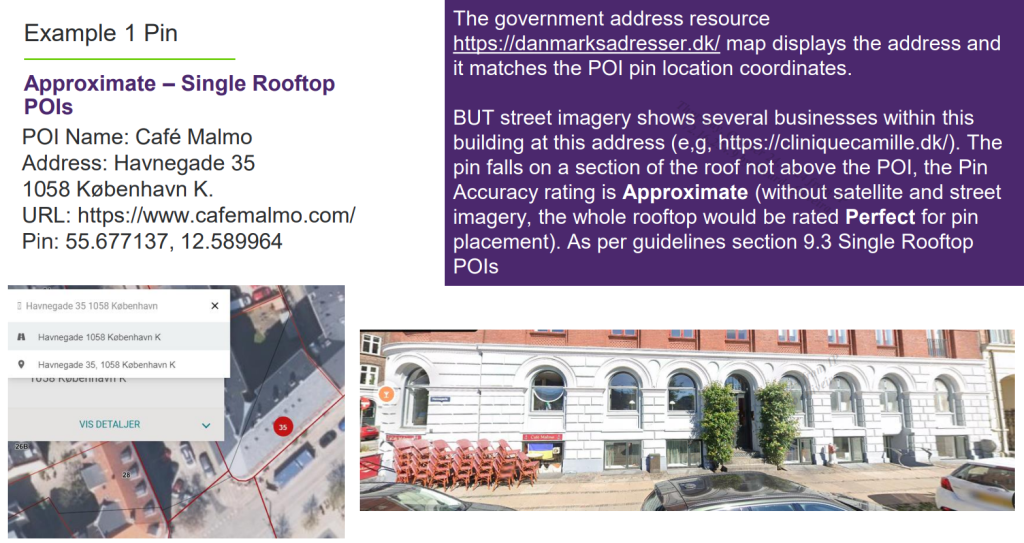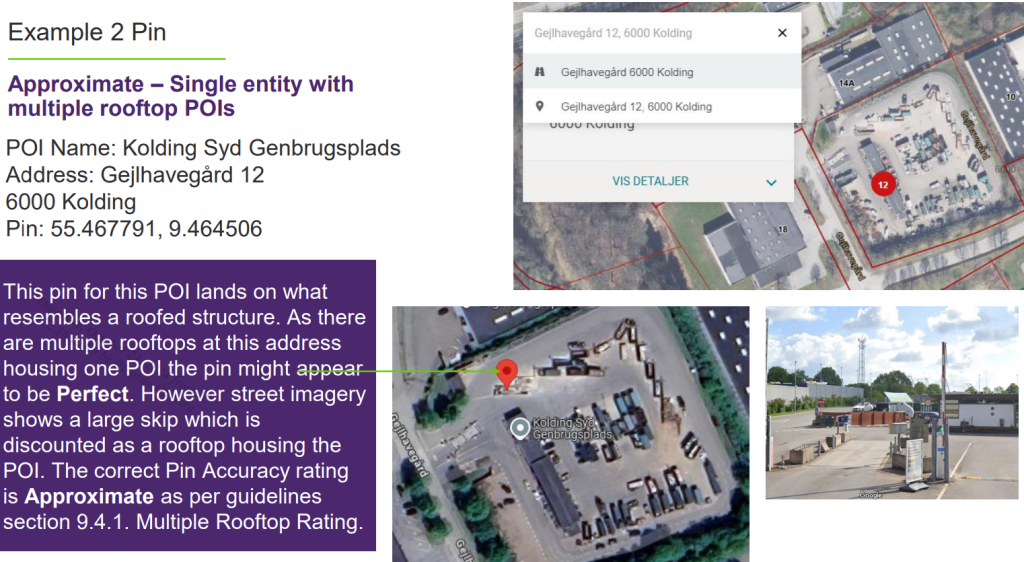This presentation provides educational content and worked examples pertinent to Denmark and are for use in combination with the POI Evaluation Guidelines
The expectations, when rating these tasks, are that analysts:
HINT: You must always perform online research to verify the POI validity and listing information
resources
• Partially Correct – Name includes corporate structure
• Incorrect – Missing sub-locality
The POI are verified using official resources, such as business’s official website, claimed social media pages, and/ or other official resources in addition to other sources listed in section 3.1.1. Research Expectations of the guidelines.
It must represent an entity in the real world that a user would want to locate on a map and that is currently active.
The validity can be rated as Yes, Yes – temporary closure, No – closed, No – no physical location, No – mobile business, No – service business out of a home, No – not a POI, Cant’ Verify.
HINT: Some POIs are not expected to have official websites or claimed social media pages.

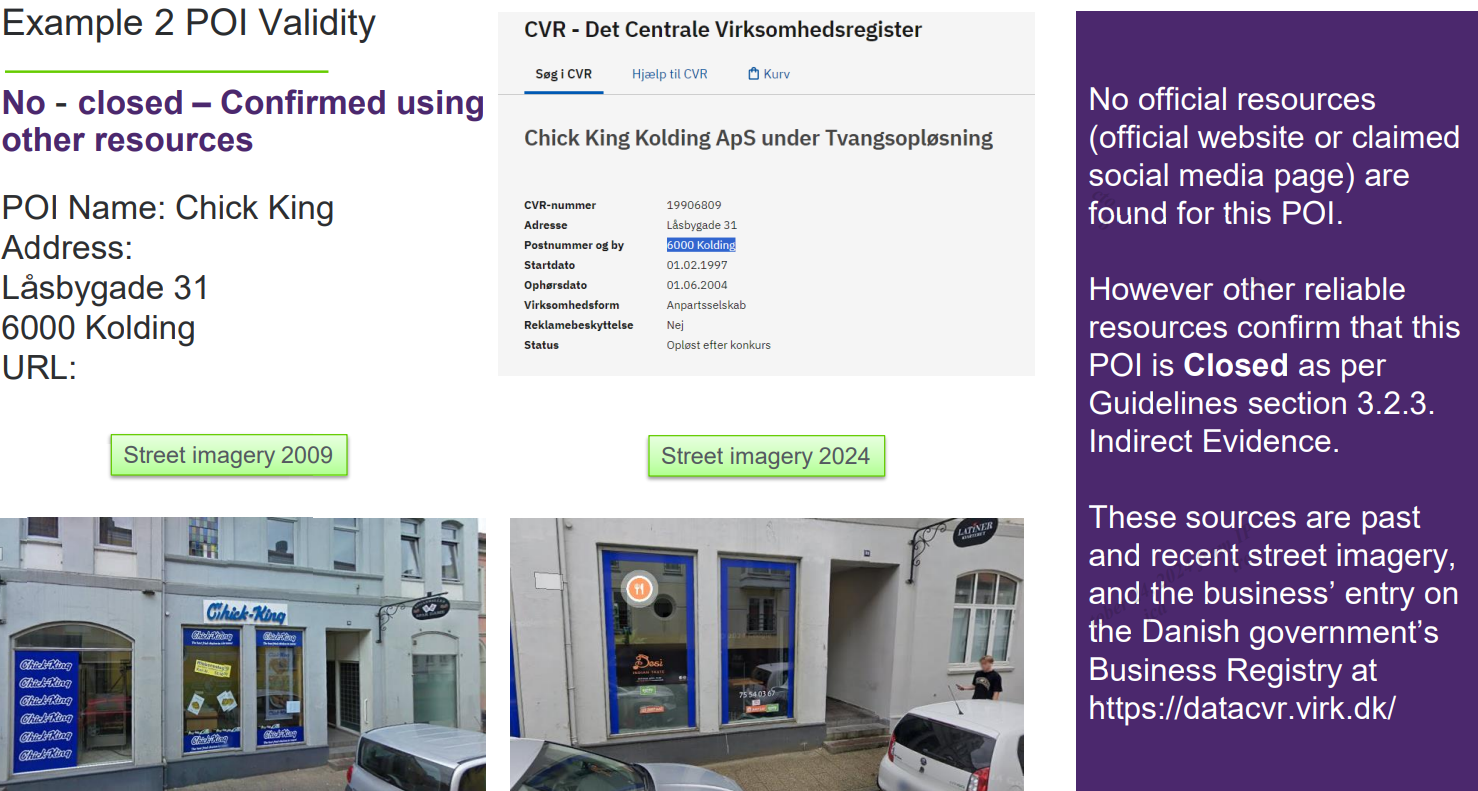
The POI name is correct when it is used on the POI’s official website or other official resources.
Every name that a specific business uses to refer to itself is considered Correct.
The name data can be rated as Correct, Partially Correct, or Incorrect.
Partially Correct is used when the name contains minor misspellings, alterations to the official name, or is a name that implies a variation in the level of service provided/ kind of business it is. Most importantly, the name can still be recognized by the user, POI Evaluation Guidelines, section 4.1.2. Partially Correct
HINT: Rate Partially Correct for any issues that don’t prevent the user identifying the POI

2.3POI Address (POI Evaluation Guidelines, Section 5. Address Accuracy)
There are several reasons that a POI address might be incorrect. Here is one of these reasons analysts in Denmark need to be especially aware of:
Incorrect – Missing Sub-locality
The POI result address does not include a sub-locality, but this appears on the official website or claimed social media page and this is a valid address component.
POI Evaluation Guidelines, Section 5.1. Address Rating Options state in such cases address should be marked Incorrect due to missing information.
HINT: Check missing components against https://danmarksadresser.dk , the government resource.

The phone number should be verified using official resources, such as business’s official website, claimed social media pages, and/ or other official resources.
The phone number data can be rated as Correct, OK Without, Missing, Incorrect or Can’t Verify.
Can’t Verify is used only when a phone number cannot be verified using an official online source, i.e. no phone number is found on any official source. POI Evaluation Guidelines, section 2.1.3 Official Resources
Missing is used when no phone number is returned but one is confirmed using either official resources, or if not available, other reliable resources. POI Evaluation Guidelines, section 2.1.3 Official Resources ‘…are used to confirm any POI details that are not available on an official web page…’
HINT: Formatting is not a reason to demote a phone number to Incorrect
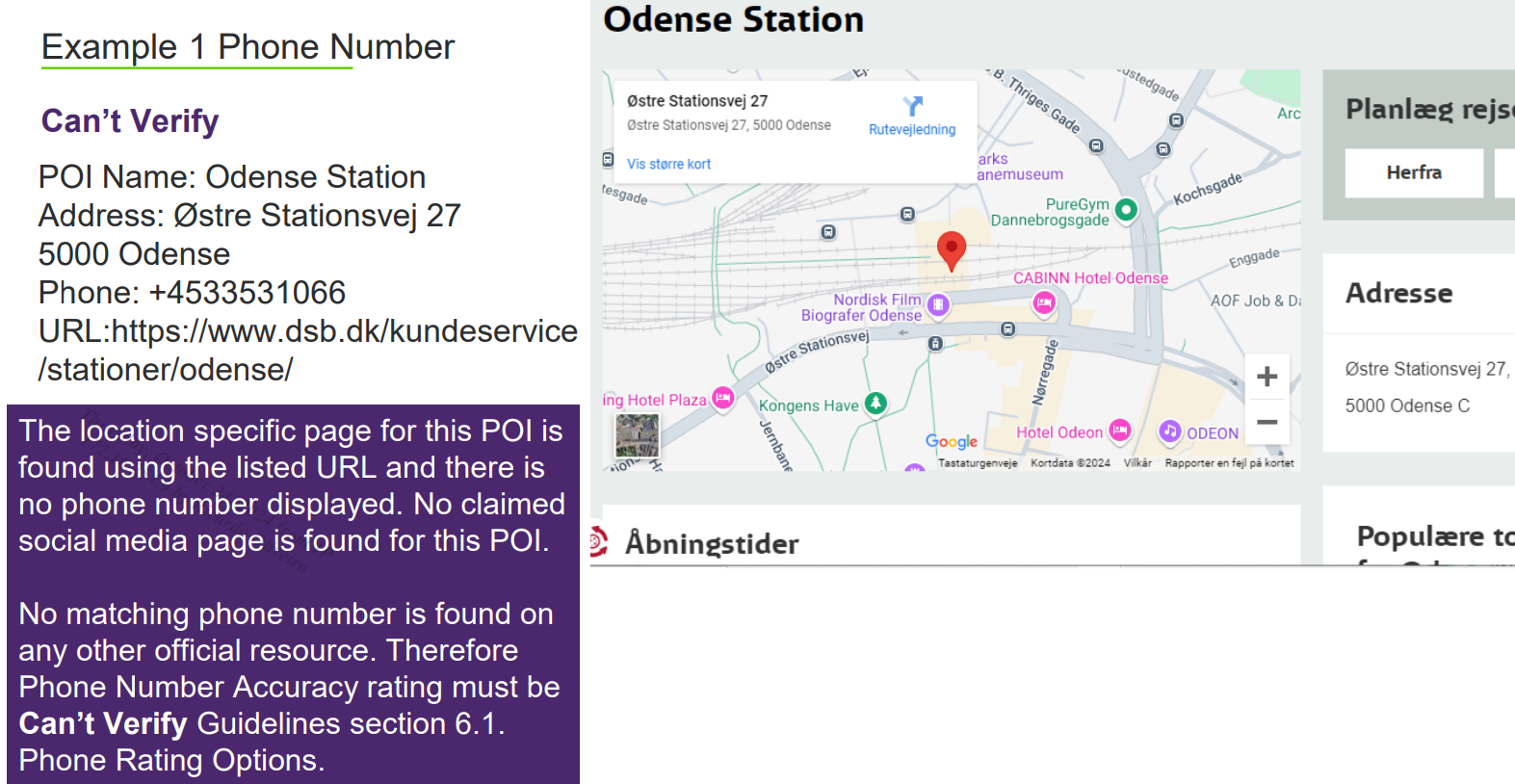
2.5URL
2.5 URL (POI Evaluation Guidelines, section 7. URL)
In the task, the listed URL is checked to see if it matches the official website address. The URL can be determined to be Correct, Partially Correct, OK Without, Missing, Incorrect or Can’t Verify.
URL Redirects
When research shows that the POI has an official website, and the listed URL navigates to the same official website the URL is deemed correct. However, if the result URL is different to the official website, even if the result URL redirects to this, it cannot be rated Correct. This can happen when a POI has rebranded or been taken over and a new website is created with the new POI name and details.
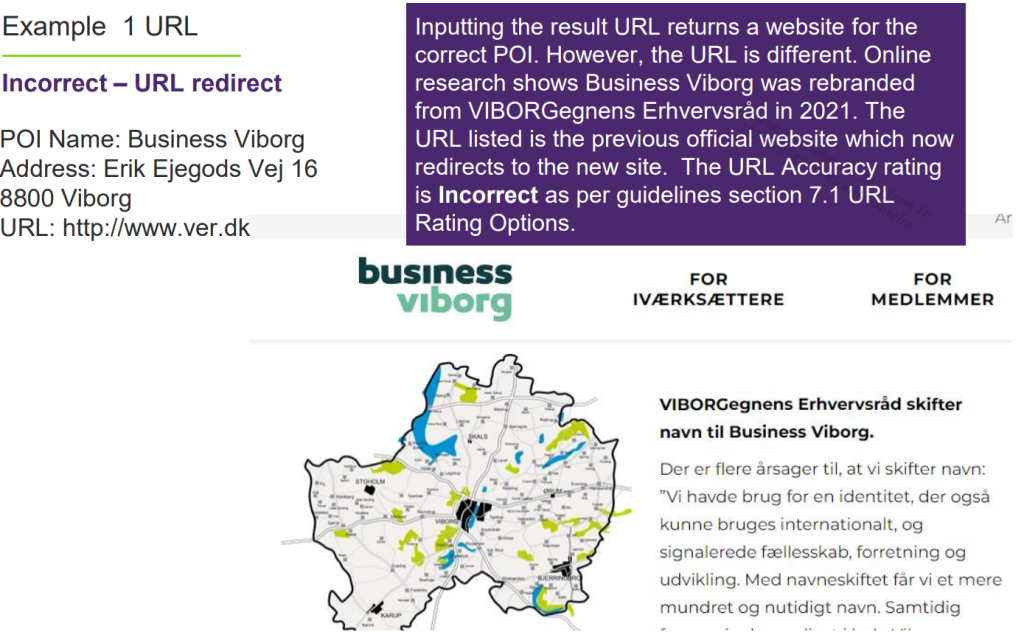
POI Name: Fasanvej/Fuglebakkevej
Address: 8210 Aarhus
URL:
Category:hotelstravel.transport.publictransport.busstops
Pin: 56.166514, 10.179514
No URL is listed in the result data. The result category indicates a bus stop which is confirmed by recent street imagery of the pin location. No website or  claimed social media page is found for this bus stop, as anticipated
claimed social media page is found for this bus stop, as anticipated
A POI’s category should best reflect the dominant identity of the POI. When evaluating the POI’s category, t.he considerations are:
A category can fully describe, generally describe, partially describe, or not describe the POI. A category that does not describe the POI should be rated Incorrect, the other rating options are Approximate – too general, Approximate – too specific and Missing.
HINT: Familiarize yourself with the POI categories and their localizations in the category list
2.6.1 Category -The Category Listegory Rating Rules
The Category list is linked to at the top of each POI Evaluation task. When selected this data table appears
Category | Name | Description |
active | Sports &Activities | Organizations and services supporting an outdoor sporting lifestyle. Parent category: not to be usi 1 |
active.airsoft | Airsoft | A facility where airsoft, a military simulation sport where players particWe in mock combat with a |
active.amateursportsteairis | Amateur Sports Team | Local sports teams, e g. baseball, football, basketball, competing at thij semi-professional level. |
active, amusementparks | Amusement Park | Commercially operated parks featuring roller coasters, shooting galleries, merry-go-rounds, and n |
active, amusementparks, ride | Amusement Park Ride | An attraction at an amusement park or carnivsil type event. |
active.amusementparks.ride.rollercoasters | Roller Coaster | Roller coasters are a type of ride at amusement parks. |
active.animalsports | Animal Sports | Sporting venues where animals are involved. |
active.animalsports. bullring | Bull Ring | A bullring is an arena where bullfighting is performed. Bullrings are often associated with the Iberi; |
active.animalsports. rodeoarena | Rodeo Arena | Professional and amateur rodeos are staged in large outdoor or indoor often air-conditioned aren; |
Rule 2 – Read reviews to help you determine the correct category
Rule 3 – When multiple categories equally describe the POI, use the business name to decide
Rule 4 – Do not rely on categories designated by Search Engine Results Pages (SERPs) or crowdsourced user review sites

2.7 Pin (POI Evaluation Guidelines, section 9. Pin Accuracy)
When rating Pin Accuracy, a judgement is made on whether the pin falls on the rooftop of a POI or feature in
question. Pin Accuracy rating is based on a consensus from multiple online resources.

Official venue materials
Rating the Pin accurately can become a little more complex in situations where POIs share spaces with other POIs, for example in shopping malls, or larger, subdivided buildings.
Pin accuracy is rated on a principle of Best Available Evidence.
HINT: Rate pin placement based on what you can actually see in the Rating Tool layers
Another pin rating possibility is that of Approximate, guidelines sections 9.3. Single Rooftop POIs and section 9.4. Multiple Rooftop POIs
A pin is considered Approximate if it drops within the boundary of the property but not on the specific rooftop or section of rooftop housing the POI as confirmed by street and satellite imagery.
The following two examples look at two different scenarios where the pin rating is Approximate.
HINT: The resource https://danmarksadresser.dk/ is a good starting point for research.
